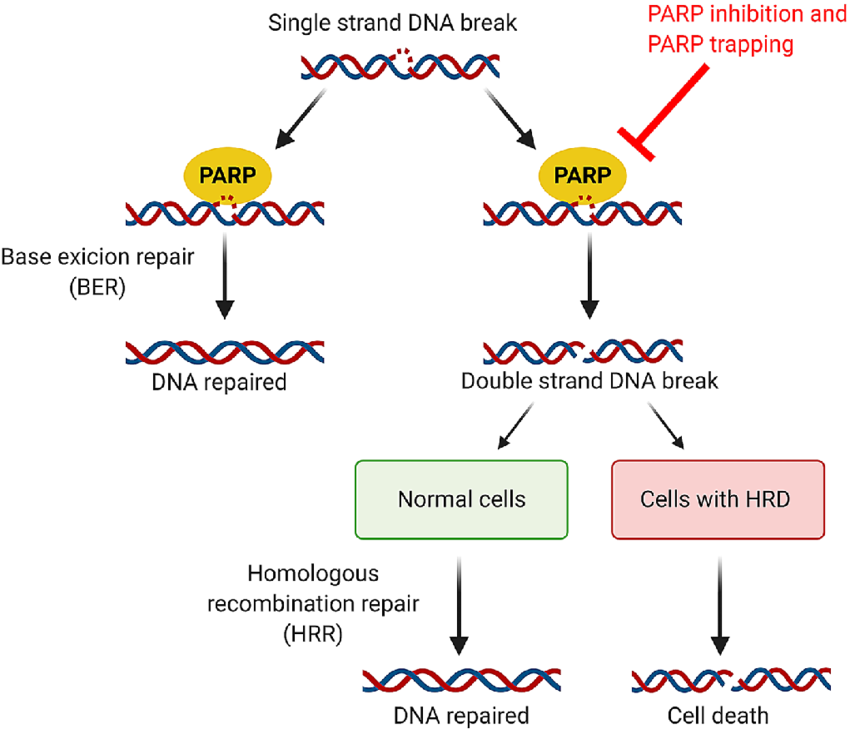Poly(ADP-ribose) polymerases (PARPs) are a family of enzymes that mediate the ADP-ribosylation post-translational modification with the substrate NAD⁺. These enzymes play critical roles in the regulation of DNA damage response (DDR), chromatin structure and transcriptional regulation. The 17 members of the human PARP family are evolutionarily conserved in their catalytic domains but have distinct regulatory domains leading to varied biology and the ability to target select members therapeutically.
The pharmacological obstruction of PARP1/2 impairs single-strand break DNA repair mechanisms which leads to synthetic lethality specifically in cancers with defective homologous recombination such as BRCA-mutated tumors and has created PARP inhibitors as effective cancer treatments. Other PARPs, such as tankyrases (PARP5a/5b), which regulate Wnt/β-catenin signaling and cell proliferation, have expanded the druggable PARP target space. Drug candidate assessment requires both catalytic inhibition and PARP–DNA trapping along with target engagement inside cells to predict in vivo activity and toxicology properly.
 Fig. 1. Mechanism of
action of poly (ADP) ribose polymerase (PARP) inhibitors (Bruin MAC, Sonke GS, et al.2022).
Fig. 1. Mechanism of
action of poly (ADP) ribose polymerase (PARP) inhibitors (Bruin MAC, Sonke GS, et al.2022).
Creative Bioarray provides comprehensive in vitro PARP screening services to efficiently and accurately assess the inhibitory potential of your compounds, accelerating your early-stage drug discovery process.
- Screening for PARP inhibitors
- Single-point concentration and IC50 determination
Assay Details
- Biochemical catalytic inhibition: Recombinant PARP enzymes catalyze ADP-ribosylation of DNA/protein substrates. Inhibitors block NAD⁺ consumption or ADP-ribose transfer.
- PARP–DNA Trapping (Fluorescence Polarization): Fluorescently labeled DNA duplex is monitored for PARP–DNA binding. Some inhibitors promote PARP "trapping" on DNA, reflected by increased FP signal.
| List of Targets | ||||
| PARP1 | PARP7 | PARP12 | PARP5B | |
| PARP2 | PARP8 | PARP14 | PARG | |
| PARP3 | PARP10 | PARP15 | ARH3 | |
| PARP6 | PARP11 | PARP5a | ||
Additional PARP family members can be incorporated upon request.
Service Highlights
- High-throughput and High-efficiency: The test is based on fully automatic platforms, which is conducive to the rapid screening of a large number of compound samples, shortening the screening time.
- Accurate and Reliable Data: We adhere to strict industry standards and use validated experimental methods, providing detailed reports to ensure the reproducibility and trustworthiness of your results.
- Customizable and Flexible: Our services can be tailored to your specific project needs, whether it's screening against a particular PARP subtype or performing different concentration gradients.
- Expert Technical Support: We can tailor our services to the specific needs of your project. Choose between targeting a specific PARP subtype or performing various concentration gradient studies.
Our PARP Screening Services offer a powerful tool for your drug discovery program, helping you rapidly identify and optimize promising PARP inhibitors. Please contact us to learn how we can support your research goals.
Reference
- Bruin MAC, Sonke GS, et al. Pharmacokinetics and Pharmacodynamics of PARP Inhibitors in Oncology. Clin Pharmacokinet. 2022. 61(12):1649-1675.
- Phosphatase Screening Services
- Phosphodiesterase Screening Services
- GPCR Screening Services
- Kinase Screening Services
- Transporter Screening Services
- Ion Channel Screening Services
- HSP90 Screening Services
- Nuclear Receptor Screening Services
- Protease Screening Services
- Ubiquitin Screening Services
- High Throughput Screening Services
- High Content Screening Services
- Target-based Screening Services
- Phenotypic Screening Services
- Apoptosis Screening
- Epigenetics Screening Services